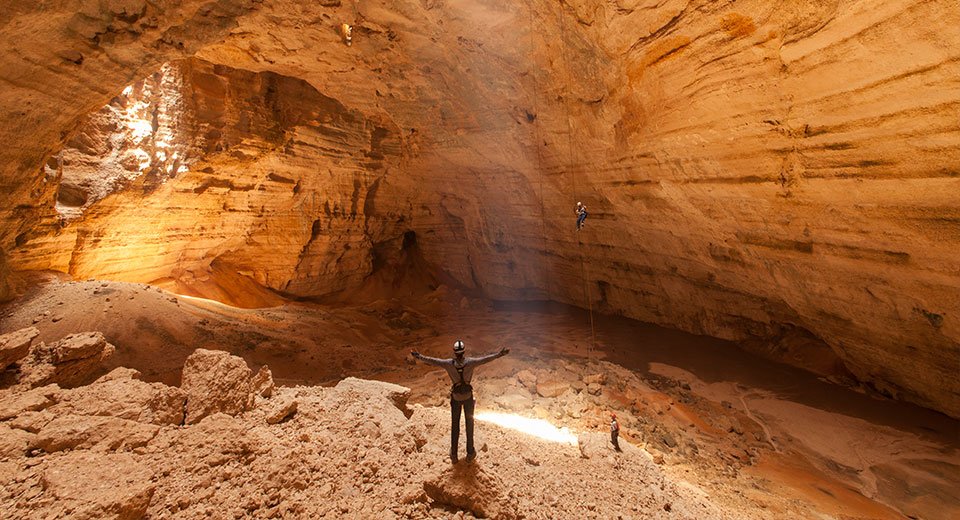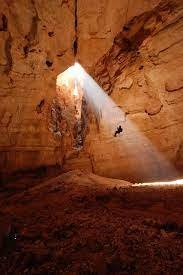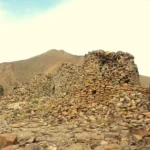Beneath the windswept Selma Plateau in northeastern Oman lies one of the planet’s most awe-inspiring subterranean realms – the Majlis al Jinn cave system, whose name translates to “Meeting Place of the Jinn.” This colossal limestone chamber ranks among the world’s largest cave volumes at approximately 4 million cubic meters, with a dome high enough to engulf the Great Pyramid of Giza. Discovered accidentally in 1983 by American geologist Don Davidson through a narrow surface fissure, the cave’s true scale was only revealed when explorers rappelled 160 meters down into absolute darkness, emerging in a cavern so vast their lights couldn’t reach the distant walls. What makes Majlis al Jinn extraordinary beyond its physical dimensions are the persistent djinn legends surrounding it – local Jebali tribes have avoided the area for centuries, whispering of supernatural guardians, unexplained lights in the desert night, and a hidden underground river said to flow with “water that drives men mad.” Modern expeditions have uncovered evidence of ancient human visitation, including mysterious stone arrangements and charcoal deposits carbon-dated to 1,200 BCE, suggesting the cave held ritual significance long before its modern discovery.
Majlis al Jinn The Descent into Darkness: Entering Earth’s Cathedral
Accessing Majlis al Jinn remains an extreme adventure requiring professional caving equipment and permits from Oman’s Ministry of Tourism. The primary entrance, dubbed “Don’s Drop,” is a heart-stopping 160-meter vertical rappel through a narrow chimney that opens suddenly into the cavern’s immensity. As explorers descend, the temperature plummets from Oman’s blistering surface heat to a constant 18°C (64°F), while humidity soars to 90%. The first visual impression is of standing in an underground Grand Canyon – laser measurements show the chamber stretches 310 meters long by 225 meters wide, with a domed ceiling arching 120 meters overhead. Sunlight penetrating through three natural skylights creates ethereal “light columns” that move across the cave floor like celestial spotlights. Most haunting is the cave’s acoustic properties – a single clap reverberates for nearly 12 seconds, while whispered conversations carry clearly across 200-meter distances. These phenomena likely fueled ancient beliefs about supernatural gatherings, as the acoustics could make small groups sound like chanting multitudes.
Geological Marvel: How Earth Sculpted a Subterranean Palace of Majlis al Jinn
Majlis al Jinn formed through a rare convergence of geological processes over 50 million years. Unlike most large caves carved by flowing water, this chamber was created primarily by sulfuric acid dissolution – groundwater reacting with pyrite deposits generated acidic solutions that ate upward through limestone layers. The cave’s distinctive dome shape resulted from unique “bell hole” weathering, where condensation droplets eroded concentric circles into the ceiling. Active mineral deposition continues today, with explorers documenting new gypsum “chandeliers” growing up to 3 meters annually. The cave floor features otherworldly formations like “cave balloons” – delicate hollow spheres of calcite that shatter at the slightest touch. In 2021, hydrologists discovered an underground stream system beneath the main chamber containing extremophile bacteria species previously unknown to science. Most remarkably, seismic studies reveal the cave is structurally stable despite its size, with the arched ceiling distributing weight like a natural Gothic vault – an architectural perfection that has endured millennia of earthquakes.
Djinn Legends and Supernatural Encounters
Local Jebali folklore describes Majlis al Jinn as the gathering place for supernatural beings during “laylat al-qadr” (the Night of Power in Islamic tradition). Elders speak of blue lights seen emanating from the cave’s entrances during certain lunar phases, accompanied by the scent of burning frankincense. Modern cavers report consistent anomalies – headlamps inexplicably dimming in specific tunnel branches, compass needles spinning wildly near certain rock formations, and equipment batteries draining at accelerated rates. The most chilling account comes from a 2015 Omani-British expedition that recorded EVP (electronic voice phenomena) of what sounded like multiple voices whispering in ancient South Arabian languages. Bedouin guides refuse to approach the cave after sunset, telling of travelers who vanished near the plateau after ignoring warnings. Skeptics attribute these phenomena to infrasound from wind passing through cave openings or magnetic mineral deposits, but the consistency of reports across cultures and centuries suggests Majlis al Jinn holds mysteries beyond current scientific explanation.

Majlis al Jinn Extreme Exploration: Pushing the Cave’s Boundaries
Since its discovery, Majlis al Jinn has attracted elite cavers attempting increasingly daring expeditions. In 2008, a team led by German explorer Herbert Wolk mapped previously unknown upper galleries containing delicate “frostwork” mineral formations resembling coral reefs. The 2017 “Deep Connections” project discovered a potential link to neighboring cave systems through a submerged siphon passage, though no diver has yet penetrated beyond 150 meters due to extreme conditions. The most death-defying feat occurred in 2019 when BASE jumper Felix Baumgartner parachuted into the chamber from a helicopter, his 7-second freefall setting a world record for indoor jumps. Modern laser scanning has revealed architectural oddities – several flat platforms at precise 30-degree intervals around the chamber’s perimeter, along with what appears to be a raised “stage” area with enhanced acoustics. These features, combined with ancient charcoal deposits, suggest the cave may have hosted ritual gatherings long before recorded history.
The Hidden Ecosystem: Life in Eternal Darkness
Majlis al Jinn hosts a specialized ecosystem thriving in complete darkness. Biologists have identified 14 endemic species, including translucent cave crickets with hypersensitive antennae and a unique species of blind scorpion that fluoresces green under UV light. The cave’s “twilight zone” near skylights supports ferns and mosses that shouldn’t survive in such arid conditions, possibly nourished by condensation from temperature differentials. Most remarkable are the microbial “living curtains” – sheets of extremophile bacteria that metabolize sulfur compounds, creating eerie bio-luminescent patterns visible in long-exposure photography. In 2022, NASA astrobiologists studied these organisms as analogs for potential extraterrestrial life. The cave’s air composition itself is unusual, with elevated CO2 levels near the floor creating temporary “invisible lakes” of heavier air that can disorient unprepared explorers. This fragile ecosystem is now protected by strict conservation protocols, with visitors required to decontaminate gear to prevent introducing foreign microbes.
Visiting Responsibly: Permits and Preparations
Accessing Majlis al Jinn legally requires booking through Oman’s officially licensed adventure operators, who provide technical equipment and expert guides. The descent season runs October-March when external temperatures facilitate safer rope work. Visitors must demonstrate rappelling experience and pass medical checks – the ascent via jumar climbing is physically grueling. Photography permits are restricted to prevent overexposure on social media, with drones prohibited to protect bat colonies. Those reaching the chamber floor describe an almost religious awe – the sheer scale defies perception, with headlamps barely piercing the darkness beyond 50 meters. The most surreal experience occurs around midday when sunlight shafts penetrate the skylights, illuminating suspended cave dust like celestial spotlights. While no supernatural encounters are guaranteed, many visitors report an uncanny feeling of being watched from the impenetrable blackness beyond their light’s reach.
Why Majlis al Jinn Captivates Scientists and Seekers
Majlis al Jinn represents a rare convergence of geological wonder, ecological uniqueness, and cultural mystique. For geologists, it’s a living laboratory of karst processes. Biologists study its extremophiles for clues about early Earth life. Adventurers crave its technical challenges. Yet the cave’s greatest power may be as a psychological mirror – its absolute darkness reflecting our primal fears and curiosities. In Omani culture, the site has become a symbol of respectful exploration, where modern science engages carefully with ancient beliefs. As laser scanning reveals more hidden passages each year, one truth becomes clear: we’ve only begun to explore Majlis al Jinn’s secrets. Like the djinn of legend, this cave reveals itself selectively, reminding us that some wonders resist full comprehension – and perhaps should remain so.
Standing on the chamber floor, surrounded by 50 million years of geological artistry, one understands why the Jebali people believed this was no ordinary cave. The immensity humbles, the silence speaks volumes, and the darkness holds mysteries no headlamp can illuminate. Majlis al Jinn isn’t just a destination – it’s an experience that lingers in memory like an half-remembered dream, calling the brave to descend again into Earth’s magnificent unknown. In a world where few true frontiers remain, this hidden underworld palace stands as a testament to our planet’s capacity for wonder – and humanity’s eternal drive to explore it.
Go to main page

